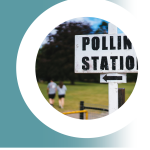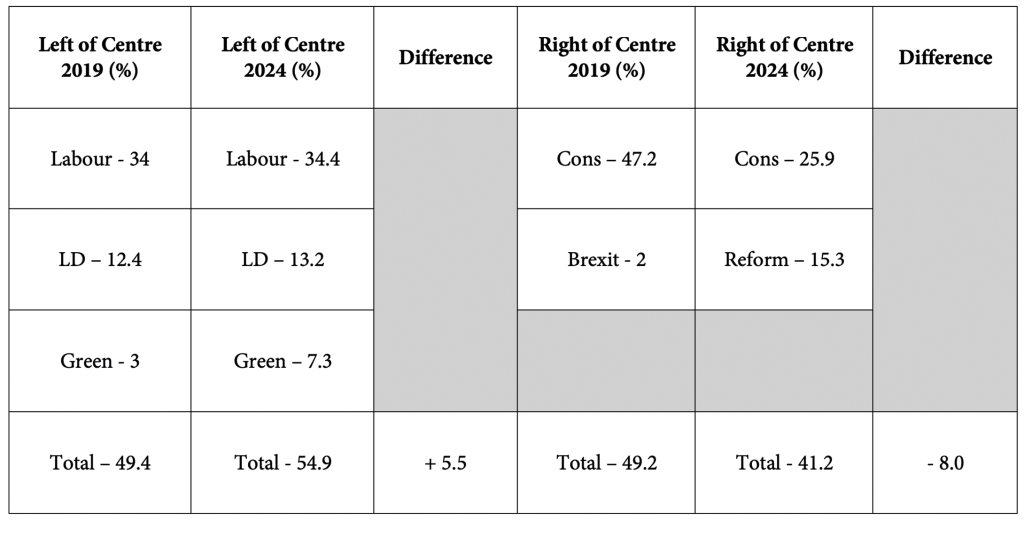
Thomas Lockwood
PhD student at York St John University specialising in modern UK elections, party systems, and democratic theory, involving both quantitative research and qualitative depth-interviews with voters.
Twitter: @thomaslockwood_
Email: t.lockwood@yorksj.ac.uk

Dr Christopher Kirkland
Senior Lecturer in Politics, York St John University
Email: c.kirkland@yorksj.ac.uk

UK Election 2024
Section 2: Voters, polls and results
13. Forecasting a multiparty majoritarian election with a volatile electorate (Dr Hannah Bunting)
14. The emerging infrastructure of public opinion (Dr Nick Anstead)
15. A moving target? Voter segmentation in the 2024 British General Election (Prof Rosie Campbell)
16. Don’t vote, it only encourages them? Turnout in the 2024 Election (Prof Charles Pattie)
17. Cartographic perspectives of the 2024 General Election (Prof Benjamin Hennig)
18. Gender and vote choice: early reflections (Dr Ceri Fowler)
19. Changing Pattern amongst Muslim voters: the Labour Party, Gaza and voter volatility (Dr Parveen Akhtar)
20. Religion and voting behaviour in the 2024 General Election (Dr Ekaterina Kolpinskaya, Dr Stuart Fox)
21. Failure to connect: the Conservative Party and young voters (Dr Stephanie Luke)
22. Youthquake for the progressive left: making sense of the collapse of youth support for the Conservatives (Prof James Sloam, Prof Matt Henn)
23. Values in the valence election (Prof Paula Surridge)
24. Tactical voting: why is it such a big part of British elections? (Thomas Lockwood)
Throughout the election campaign, there were discussions concerning tactical voting and its prevalence in this election. According to polling, 19% of voters intended to vote negatively to keep another party out, rather than voting their desired party in, on the same par as 2017. These voters, if following through with this intention on polling day, opted for a “compromise” candidate – someone whose politics they may not share but is better placed to defeat their least preferred candidate.
The influx of tactical voting websites, campaign groups, and their social media presence, has made this more of a possibility. Ahead of the vote, one centre-left campaign group created a voting hitlist of 451 constituencies where the Conservatives can be voted out. The aim was to encourage voters to cast their ballot in a way that delivers the heaviest possible election defeat to the Conservatives.
Tactical voting is predominantly discussed on the left of British politics and in 2024, aimed squarely at removing the Conservative government from power. However, we should be cautious as to the national effects of such voting, not least given tactical voting has not prevented the Conservatives winning the last four General Elections.
Tactical voting also makes assumptions about the Conservative Party vote; largely that it remains sufficient to challenge either the Labour, Lib Dems, Greens or any other candidate in the majority of constituencies. A sharp fall in Conservative vote share (from 42.6% to 23.7%) demonstrates that in many areas this simply wasn’t the case.
The effects of tactical voting were therefore confined to a relatively small number of constituencies – in fact an even smaller number that was being predicted at the start of the campaign. The outcomes of high-profile names or constituencies (such as South West Norfolk, North East Somerset or North West Cambridgeshire) may have been influenced by tactical voting, but the majority of seats are unlikely to have been.
Tactical voting works when voters are divided into broad coalitions. Here voters who support a (self-defined) ‘left wing’ or progressive party may be expected to lend their vote to a party that shares similar values and policies in exchange for removing an undesirable incumbent/opponent. Interestingly, a pre-election study found that Labour and Liberal Democrat voters share a great deal between them vis-a-vis beliefs and outlooks. This should therefore be fertile ground for tactical voting between the parties.
Instead, the Labour and Liberal Democrat vote shares both increased, albeit marginally, by just 1.6% and 0.6% respectively. Figure 1 illustrates how we can reduce the vote in England to two broad coalitions (nationalism makes it difficult to reduce voting in Scotland and Wales in a similar vein), with the Labour, Lib Dems and Green party representing a left or left of centre bloc and the Conservatives and Reform/Brexit party representing a right or right of centre bloc.

This suggests that rather than sharing votes between these parties, people switching from the right leaning to left leaning parties was the primary factor behind the change in government.
Importantly, however, we do not know for definite the scale of tactical voting in this election. People aren’t asked their reasons for voting on polling day, or even if they voted for the party that most aligned with their values. These are personal decisions. Voters are also of course free to change their minds between opinion poll field work (which asks if there was an election tomorrow which party would you vote for) and putting their ballot in the official ballot box/ returning a postal vote.
Nonetheless, drawing upon previous studies of recent election cycles, the number of people indicating a willingness to engage in tactical voting decreased (see above), and given the nature of the FPTP electoral system, it is unlikely that tactical voting significantly impacted the overall election results. Tactical voting was only slightly more prevalent in 2019 than in this or other previous elections. In 2019, neither the Unite to Remain pact nor the Brexit Party’s withdrawal of candidates significantly affected the results.
Though this isn’t to deny that people may have voted tactically – in essence we can’t know this unless large scale qualitative analysis occurs. It simply means that such voting had little impact on the election outcome, which was skewed by the ‘winner takes all’ nature of the FPTP electoral system. This is because FPTP ultimately rewards parties that gain a sizable minority of votes and punishes those unable to gain 25% of the vote share.
